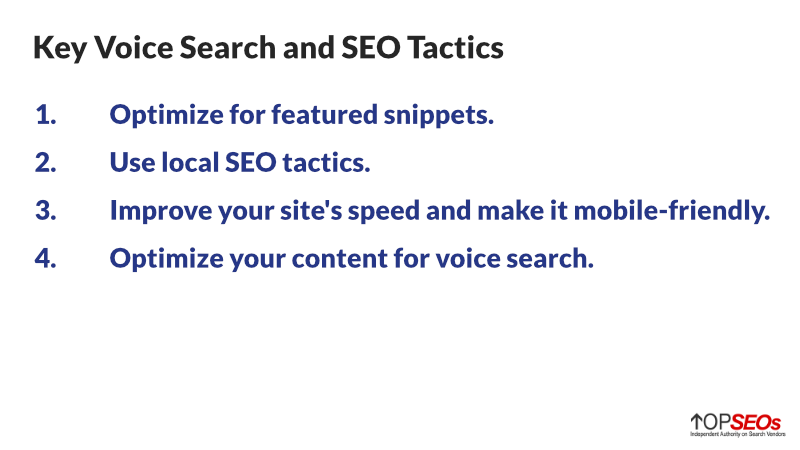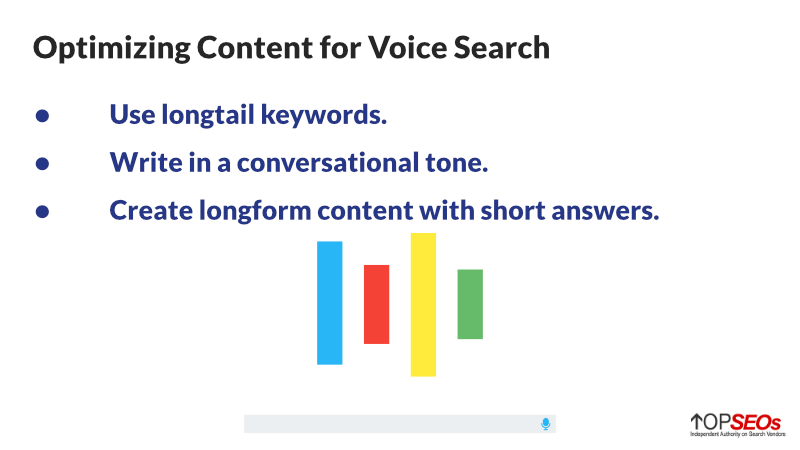Searching the internet has never been as easy as it is right now. With voice search, you can get directions, check the weather, and even make purchases. But how do voice search and SEO work together? And how can you optimize both?
In this article, we’re going to tell you all about voice search SEO, why voice search is important for SEO, and provide four key voice search and SEO tactics you can use to make sure your content ranks higher and comes up for those coveted voice search answers.
What is Voice Search SEO?
In marketing, voice has been attached to many things like voice search, voice marketing, voice assistants, and a lot more. So, how does SEO fit in?
Marketers already take the time to optimize our content and PPC for search engines like Google. We use high-quality images, search intent, content length, and other things to let search engines and searchers know that our content is the content that will answer their questions thoroughly.
But we don’t do a great job at optimizing those things for voice search. This puts us at a disadvantage.
Why Is Voice Search Optimization Important?
Voice search makes it ridiculously easy to get your questions answered quickly and easily. Just pull out your smartphone or talk to your smart speaker and the internet is just a tiny question away.
As more and more voice technologies are released, searchers will use them more frequently to conduct searches. Since Google already places a lot of ranking importance on how well your content matches searcher intent, it’s likely that plays a huge role in whether or not your content is used for voice search.
Plus, it’s entirely possible that increased use of voice search will lead Google to make additional changes to its ranking factors. After all, Google switched to mobile-first indexing way back in 2018, when mobile search just started to outpace desktop search. It’s only a matter of time before voice-first indexing becomes a thing.
The bottom line is that your digital marketing strategy directly impacts your brand’s success. Voice search is going to have an increasing impact on your brand as more and more people adopt the technology.
As marketers, we are used to adjusting to changing ranking factors; we can’t overlook voice search.
Remember, our ultimate goal should be to give users what they need quickly and efficiently and leave them with warm, fuzzy feelings about our brand. Voice search is a way we can do that.
4 Key Voice Search and SEO Tactics

Some believe that voice search means the end of SEO as we know it, and that may well be the case.
But as long as there are search engines, there will be a need for SEO. It just might look a bit different.
Voice search and SEO aren’t at odds with each other. In fact, optimizing for voice search can actually improve your SEO efforts for traditional searching.
And to be clear, voice search does impact SEO. Using conversational language, focusing on earning those coveted featured snippets, building high-authority content—all of these are things that voice search and SEO have in common.
Voice search and SEO primarily differ in the way searches happen.
When we’re typing a search into Google or some other search engine, we use keywords: “plumbers near me.” For voice searches, we treat our smartphone or smart speaker more like a friend: “Okay Google, who are the best plumbers near me?”
It’s much more conversational and friendly.
Let’s explore four (it’s actually more like seven) voice search and SEO tactics that will get you ranked higher and get your content brought to life through voice search.
1. Optimize for Featured Snippets
Featured snippets, the coveted “position zero,” are used in answers to voice queries roughly 60% of the time. These work well for voice search because the pertinent information is all right there, laid out for the smart device to read aloud to you.
This is a great place to start your voice search and SEO efforts. But, it’s not exactly easy to get a featured snippet and for high-competition keywords, they can be tricky to hang on to.
So, how do you get a featured snippet?
For starters, you need to optimize your content to answer questions. You can use tools like AnswerThePublic and QuestionDB to find out the questions that users are actually asking. Then, use those questions and provide answers in your content.
Focus on answering questions in lists, tables, or paragraphs of fewer than 50 words. Keep your sentences short and free from buzzwords or jargon. And, don’t forget to include your target keyword.
While you will need to be on the first page of the search engine results pages (SERPs), you don’t actually have to be ranked first to get the featured snippet. In fact, 70% of featured snippets come from positions two through five!
Relevance matters more than ranking position (once you’re on the first page).
2. Use Local SEO Tactics
Voice search is often used to find local businesses and include “near me” or “local” in the queries.
This means that your information needs to appear consistent no matter where you show up online. If your Yelp address is different from Google Maps, and that’s different from what’s in your Google Business listing, well, it’s less likely that your business is going to get included in the top local rankings.
Google doesn’t like being confused and it doesn’t want to confuse searchers.
In addition to keeping your contact information consistent, you should use schema markup. This is simple coding that’s added to your site to make it easier for search engines to understand.
Along those same lines, rich snippets can improve your site’s SEO. This is additional text that Google shows with your meta description and URL in search results.
With all of that, you need to also use local SEO best practices to ensure that your local business is optimized.
This includes things like your business listings pages, citations, reviews (and responses), social media, inbound links, and creating local content, among others.
Google My Business
Your Google My Business (GMB) page is important to get your business found online. We recommend optimizing your images and information, but also adding content and posts to your GMB page.
3. Improve Your Site’s Speed (and Take It Mobile)
Since 2018, Google has been indexing websites using mobile-first indexing. This means that your website is indexed depending on its mobile view.
Google made this change in response to increased searches from mobile devices. If people are searching from mobile devices, they should get results optimized for those devices to ensure a good experience, right?
You can use Google Search Console’s mobile-friendly testing to make sure that your site works well for mobile devices. You’ll also get recommendations on how you can improve your site’s mobile-friendliness.
Site speed and mobile-friendliness are connected. If you’re out and about and search something on your smartphone, the page better load fast or you’re going to bounce to the next best.
Improving your site’s speed ensures a quality user experience. This means that more people will choose your result and in turn, it will be ranked higher (and more likely to be used in voice search responses).
4. Optimize Your Content for Voice Search
We already talked a little bit about content optimization for voice search, but there’s a lot that goes into it.
Voice search is more conversational than traditional searches, but that doesn’t mean you can sacrifice high-quality information. Your answers need to be both packed with information and provide short, fast answers in a format that makes it voice search-friendly.

A top-ranked content marketing company can help you get the most out of your content. But, if you want to go it alone, here are some ways to do it:
Longtail Keywords
Voice searches are more conversational which tends to mean longer keyword phrases. These longer phrases are called longtail keywords.
Longtail keywords are usually much more targeted and, therefore, generate fewer search results.
And that’s a good thing!
When you have more targeted search results, the traffic that gets to your page is much more likely to convert because the intent is higher for that highly-targeted keyword.
In terms of keywords, this means using more specific phrases. Instead of optimizing for “plumbers,” you’d optimize for “affordable plumbers in St. Louis MO,” for example.
Conversational Tone
As voice recognition technologies improve, using a conversational tone in your content will be increasingly important. We’ll be making voice searches in much more relaxed and natural language and if your content doesn’t fill that bill, it simply won’t be ranked as high.
But how can you use a conversational tone in your content?
It all starts with understanding search intent. This is vital if you want to know how people are actually wording voice searches.
This involves finding out:
- The types of questions that are asked and that are asked most frequently
- The types of answers that work best for those searches
- Which answers do well on SERPs and are used in voice search results
- The conversational styles that your target audience uses
This type of research will help you create an evidence-based voice search and SEO strategy that you can use to get your content in front of searches whether they using voice or traditional search.
Longform Content With Short Answers
One of the best ways to optimize your content for voice search is to provide short answers of two or three sentences to commonly asked questions.
While Google often sources responses for voice searches from longer texts, it’s a lot easier to get your content featured in response to a voice search when it’s in a smaller body of text or an FAQ.
When the answers are in shorter bodies of text it makes them easier to access. And easier means faster.
Unlike traditional searches, voice searches will read off the first answer that comes up. This makes it very important to keep your content optimized for higher rankings.
So, does this mean that your content need only be a few sentences long?
Not a chance.
Even with voice search, search engines like Google reward content that offers an in-depth response that hits a searcher’s intent. This most often occurs with longform content.
Additionally, longform content tends to get more backlinks than shorter content. This can do a lot for your domain authority. And, a higher domain authority means higher rankings.
If you really want to boost your link building efforts, hire one of the top-ranked link building companies!
By and large, the best way to optimize your site for both voice search and traditional search is by producing high-quality, longform content.
Wrapping Up
Voice search adoption is increasing. This means that voice search is already impacting the way we as marketers are building SEO strategies.
Rather than waiting until voice search is the default for the majority of searches and Google has switched to voice-first indexing, you can stay ahead of the curve with the tactics we’ve outlined here.
If you’re looking for an SEO company that can take all of this off your hands so you can focus on running your business, try out one of the top-ranked SEO companies to handle it for you.




















